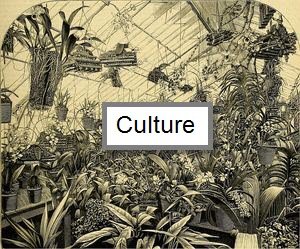Orchids are grown and loved primarily for their beautiful flowers. However, many orchid owners do not know what to do after the orchid has flowered. Should it be thrown away like any annual plant, should it be left alone, or does the orchid requires special care after blooming?
To answer these questions:
Orchids are not annul plants, meaning they do not live for just one season. Do not throw away any of your orchids, even if it shrivels and appears dead. With proper care every orchid will continue to grow and flower year after year. Providing your orchid with adequate light, water, fresh air and optimum temperature is more than enough to keep the orchid on the path of growth. Fertilizers also help in boosting growth when growing exotic orchids.
Taking Caring of Your Orchids
Every orchid requires specific care. Those orchids which lose their leaves and appear to wilt or shrivel, survive by special parts such as rhizomes and pseudobulbs, which regrow shoots after sometime (on the advent of favourable conditions). In some orchids, like the Dendrobium or the ‘Weed Orchids’ leaves are shed before flowering and the stem (pseudostems) appear shrivelled, but with regular watering the orchid survives to flower in the next and the next season. There are also orchids which do not shed their leaves and remain green throughout the year, like the Phalaenopsis, Cymbidiums etc. For such orchids just cut the flowering spike and remove the scales of dead leaves.
How to Tend to Your Orchid After Blooming
Like other plants, orchids also spend a lot of energy on flowering. So once the flowering is over, it requires a period of rest. To prepare the plant for rest follow the steps given below.
• Once the flowers or the flowers on the stalk die off and start to wilt, cut it off with a clean trimming tool. Sometimes, if the flowering stalk (spike) is not removed completely, and a small stump is left. This induces the orchid to produce a new offshoot from the cut off old flowering stalk and flower again. But, this does not happen immediately. Flowering starts once the orchid has had its rest and regained the strength to flower again.
• After removing the old flowering stalks, you can remove the yellowed leaves too.
• The orchid can be repotted, if it has overgrown its container. Some orchidologists advice repotting to make the orchid flower again in the same season, but I am not sure of this, as I have not tried it myself. However, I know that repotting an orchid once the flowering is over, can help the orchid grow better.
• Orchids having bulbs, need to be taken care in a different way. When these bulbs lose their leaves they can be stored. Best option is burying the leafless pseudobulbs in sand, which is occasionally moistened. These bulbs can be planted in the next growing season, and from it will grow out a brand new orchid to flower again.
• Whether or not the orchid is repotted, it needs to be left undisturbed for some time. So after repotting, let your orchid have a good rest with adequate water and light (to produce food).

Post Flowering Care Of Orchids
Cultureby Anu Dharmani
Originally published in BellaOnline
Posted by Sys Admin almost 9 years ago.Article Blog Article Index
Share on Social Media:
New Topics
- David George asked question Odom's Fascination - an unusual orchid in category General Discussion
- Carol Holdren asked question Grow Tent in the Garage in category General Discussion
- David George asked question rlc Caotan Beauty found at Home Depot in category Cattleya Alliance
- Kristin Dorris asked question Odontocidium Orchid fungus? in category General Discussion
- Maria Fernandez asked question Wild. Lisa Devos in category Dendrobiums
New Comments
- Carol Holdren commented on topic "Odom's Fascination - an unusual orchid" by David George
- Dr. Florian Wolf commented on topic "Wild. Lisa Devos" by Maria Fernandez
- Michael Valcarcel commented on member plant Rlc. Chief Takanaka by Walceli Muniz Valverde
- Michael Valcarcel commented on member plant Rlc. Montana Spirit by Michael Valcarcel
- Michael Valcarcel commented on member plant Ctt. Blazing Sun by Michael Valcarcel
- Michael Valcarcel commented on member plant Bc. Spotted Clown by Michael Valcarcel
- Maria Skrypnyk commented on member plant Yamadara Redland Sunset by Maria Skrypnyk
- André Pessina commented on topic "Odontocidium Orchid fungus?" by Kristin Dorris
- Linda Hartman commented on topic "Image of a plant please" by Leshya Perkins
- Paul Reavis commented on orchid Milt. Kismet
- Christiaan Viljoen commented on member plant Psh. fragrans by Christiaan Viljoen
- Christiaan Viljoen commented on member plant Z. maculatum by Christiaan Viljoen
- Christiaan Viljoen commented on member plant C. Gaskell-Pumila 'Azure Star' by Christiaan Viljoen
- Robert H. Findlay commented on member plant Rlc. Joy Sokabe var. Volcano Queen by Sally K
- James Lunsford commented on member plant Lc. Sagarik Wax 'African Beauty AMO/AOS x Blc. Cherry Suisse'Kauai' HCC/AOS var. Cattlyea 'Hybrid ' by James Lunsford
- John Varigos commented on orchid Bulb. schwarzii
- Linda Hartman commented on topic "Issue with Blc. Ben O'Neil "Jubilee" by Glenda Ratliff
- Henry Shaw commented on member plant Ons. Catatante 'Los Roble' by Henry Shaw
- Mary Lane commented on member plant Den. Tianmu Canary by Terre Moore
- Pamela Stegmaier commented on member plant Rlc. Esther Costa var. Orange Fantasy by Mary Lane